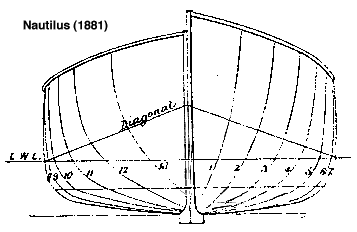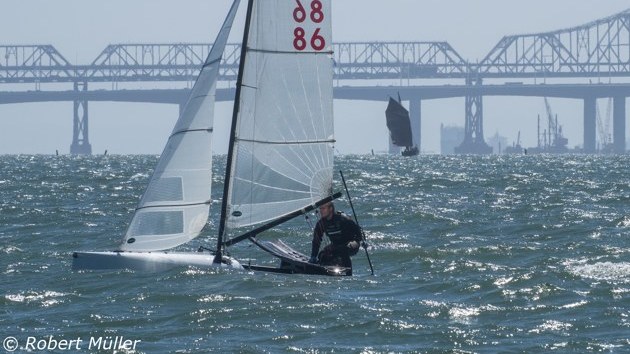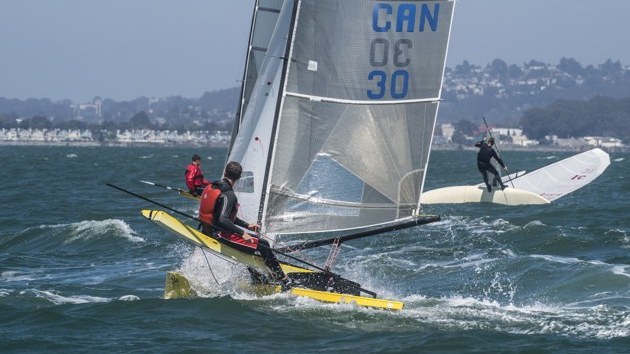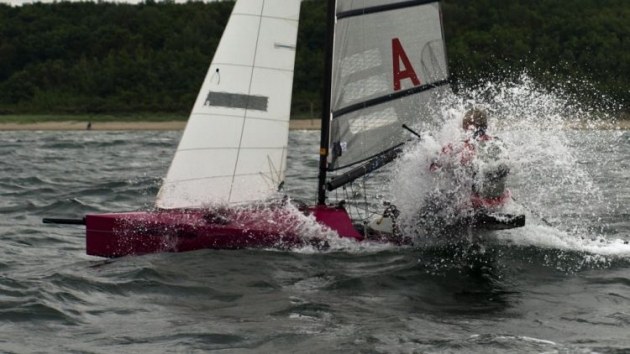The Decked Canoe Archives
Assembled by Tim Gittins
Nautilus
Date: 1880
Designer: W. Baden-Powell

The Nautilus of 1881 was designed by Warington Baden-Powell and was built in the autumn of 1880. This is Nautilus #8. The intended use was for cruising on "navigable rivers, lakes, and the sea. Being intended chiefly for cruising, many sailing points were put aside for cruising requirements; still it performed well as a sailer." "In such a craft, compactness of dimensions, lightness of hull and fittings, and other requisites for ease of transportation, were considered of secondary importance to seaworthiness and sail-carrying power; and the canoe was intended more for pleasure cruising in ordinarily frequented navigable waters than as a travelling craft for navigating inland lakes, rivers, and canals in thinly-populated districts."(Kemp, 1882)
The diagram below shows the body plan of the 1881 Nautilus. Notice the depth of this canoe. Remember, this hull is 33 inches wide. This attests to its use as a sailing canoe much more than a padding canoe, especially in windy conditions where paddling this high-sided canoe would prove very strenous. Baden-Powell concedes..."As to paddling against a head wind in open water in any [boat] but a long, low, narrow paddling canoe, it is simply self-inflicted hard labour; sails would do the work in far less time, and with ease and comfort to the canoeist." (Kemp, 1882). Two other distinguishing features is the quick turn of the bilge relative to other hulls of it's time and the sudden tapering of the stern.
Body Plan

This Nautilus used mahogany for its planks, decks and fittings. and oak for ribs. The Nautilus also carried an 83 lb. center-plate and 100 lbs. of lead shot in bags to be used as ballast. It's clear that this canoe was not intended for travelling to inland lakes! The canoeist was expected to sail this canoe, although Baden-Powell writes that "wind failing, the canoe can be paddled with the double bladed paddle with ease, or the half-paddle may be used in conjunction with the foot-steering gear."(Kemp,1882) Whereas the canoeist is coming out of the well and sitting on the deck in North America, Baden-Powell is choosing instead to lay further down inside. The "result is an all-round gain in comfort to the skipper and of strength and dryness to the craft." (Kemp, 1882)
The following table, published in the 6th edition of Dixon Kemp's 'A Manual of Yacht and Boat Sailing', 1882, shows the dimensions and leading points of the design. All measurements are in inches.
| Heights | Half Breadths | ||||||
|---|---|---|---|---|---|---|---|
| 1* | 2* | 3* | Deck | L.W.L. | #2 W.L. | Diagonal | |
| 0 | 16 | - | - | - | - | - | - |
| 1 | 14.25 | 5 | 1 | 6 | 3.25 | 1.75 | 4.75 |
| 2 | 12.75 | 5.75 | 1 | 10 | 6.5 | 4.25 | 8.25 |
| 3 | 11.25 | 6 | 1 | 12.75 | 9.75 | 7 | 11.25 |
| 4 | 10 | 6 | 1 | 14.5 | 12.5 | 10 | 13.75 |
| 5 | 9.25 | 6 | 1 | 15.5 | 14.75 | 12.25 | 15.75 |
| 6 | 8.75 | 6 | 1 | 16.25 | 15.75 | 14.25 | 16.75 |
| 7 | 8.5 | 6 | 1 | 16.25 | 16.25 | 15.5 | 17.25 |
| 8 | 8.25 | 6 | 1 | 16.5 | 16.25 | 15.5 | 17.25 |
| 9 | 8.25 | 6 | 1 | 16.5 | 16 | 14.5 | 17 |
| 10 | 8.75 | 6 | 1.25 | 16 | 15 | 12.5 | 16.25 |
| 11 | 9.5 | 6 | 1.25 | 14.75 | 13.25 | 9 | 14.5 |
| 12 | 10.5 | 5.5 | 1.5 | 12.75 | 9.755 | 4.5 | 11.5 |
| 13 | 11.75 | 4.5 | 2 | 8.5 | 4.5 | 1.5 | 7 |
| 14 | 13.5 | - | - | - | - | - | - |
1* : Height above L.W.L. to underside of deck
2* : Depths below
L.W.L. to rabbet
3* : Depth of keel and metal band below rabbet
Half-breadths are taken at deck, at L.W.L. to outside of plank,
and at 3 in. below L.W.L. to outside of plank (#2 W.L.)
Diagonal
half-breadths from 6 in. above L.W.L. to L.W.L. at No. 7
Total length, 14 ft.; beam, 2 ft. 9 in.; depth inside, 16 in.; Keel,
2 in.; draft, 7 in.
Sections 1 ft. apart, No. 1 being 1 foot
from fore end L.W.L.
Stem and stern posts sided at rabbet, 1.25
in.
Keel from No. 2 to No. 7 sections sided 2 in. tapers to
ends.
Ulrike_veerkamp.jpg)
Ulrike_veerkamp.jpg)



Ulrike_veerkamp.jpg)
Ulrike_veerkamp.jpg)
Ulrike_veerkamp.jpg)
Ulrike_veerkamp.jpg)
Ulrike_veerkamp.jpg)


